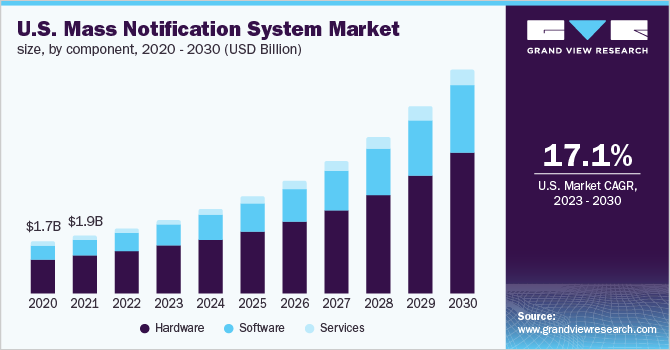The Mass Notification Systems Market is poised for significant growth, projected to soar from US$ 13.18 billion in 2023 to an impressive US$ 41.86 billion by 2032. This forecast, according to a recent study by Astute Analytica, highlights a compound annual growth rate (CAGR) of 13.7% over the period from 2024 to 2032. The driving forces behind this surge include escalating security concerns, the urgent need for effective crisis communication channels, and the integration of advanced technologies such as cloud computing, artificial intelligence (AI), and the Internet of Things (IoT).
Market dynamics: Security and technological advancements
The global landscape of mass notification systems (MNS) is evolving rapidly, fueled by a heightened demand for robust communication technologies across various sectors. Businesses and governmental bodies alike recognize the critical role of MNS in enhancing safety and operational efficiency. Notably, the education sector sees a near-universal agreement on the necessity of campus-wide MNS implementations for safety communication, with a staggering 95% of decision-makers affirming their indispensability.
Healthcare and corporate sectors are also making significant strides in MNS adoption. Healthcare institutions leverage these systems for emergency codes and patient management, while corporations incorporate them to mitigate physical security risks, protect assets, and ensure employee safety. The widespread use of IP-based solutions offers scalability and flexibility, enabling multi-channel alert integration and IoT connectivity for comprehensive and context-aware alerting mechanisms.
Technological innovations shaping the future
The mass notification systems market is on the brink of a technological revolution, with cloud-based solutions, AI integration, and IoT connectivity at the forefront. These advancements promise enhanced targeting, automation, and intelligent filtering, translation, and threat analysis capabilities. Cloud-based solutions, in particular, offer unprecedented flexibility and scalability, while AI-powered enhancements are set to revolutionize alert prioritization and emergency preparedness.
North America emerged as the largest market in 2023, accounting for 34.0% of the global share, indicative of the region’s advanced technological infrastructure and stringent regulatory compliance requirements. The dominance of solution components, which represented 81.3% of the market, underscores the critical importance of sophisticated MNS solutions in today’s digital age.
Challenges and opportunities facing mass notification systems market
Despite the optimistic growth outlook, the mass notification systems market faces several challenges. Key among these are ensuring cybersecurity and data privacy in an increasingly interconnected ecosystem, managing the complexity of integrating multiple channels and devices, and extending reach to populations in areas with limited technological infrastructure.
However, the market’s consolidated nature, with the top five players capturing more than 67% of the revenue share, points to a competitive landscape ripe for innovation and disruption. Honeywell International Inc. leads the pack with an 18% market share, but the dynamic nature of the market suggests ample opportunities for new entrants and smaller players to make their mark, especially through technological innovation and niche specialization.
Strategic insights for stakeholders
The report by Astute Analytica offers invaluable insights for stakeholders in the mass notification systems market. It highlights the pivotal role of MNS in business continuity and disaster recovery, with more than 42% of the market’s revenue attributed to these applications. The findings emphasize the urgency of adopting MNS for organizations to mitigate hazards swiftly and effectively, recover from interruptions more rapidly, and comply with regulatory standards.
The mass notification systems market is set for explosive growth, driven by the confluence of increasing security concerns, the adoption of cutting-edge technologies, and the integral role of MNS in ensuring public safety and operational continuity. As the market evolves, stakeholders must navigate the challenges of cybersecurity, complex integrations, and expanding access while capitalizing on the opportunities presented by technological advancements and market consolidation.





